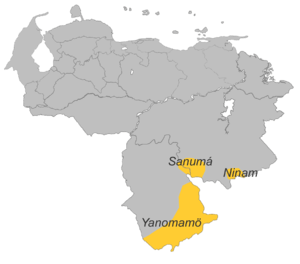Yanomaman languages
| Yanomaman | |
|---|---|
| Ethnicity: | Yąnomamö |
| Geographic distribution: | Amazon |
| Linguistic classification: | One of the world's primary language families |
|
| |
| Glottolog: | yano1260[1] |
|
Yanomaman languages in Venezuela | |
Yanomaman (also Yanomam, Yanomáman, Yamomámi, Yanomamana, Shamatari, Shirianan) is a spoken by about 20,000 Yanomami people in southern Venezuela and northwestern Brazil (Roraima, Amazonas).
Subdivision
Yanomaman consists of five languages, very similar to each other, sometimes classified as a dialect continuum:
Sunumá is the most lexically distinct. Yanomamö has the most speakers (20,000), while Yanam and Yaroame have the fewest (400 apiece).
Genetic relations
Yanomaman is usually not connected with any other language family. Joseph Greenberg has suggested a relationship between Yanomaman and Macro-Chibchan. Migliazza (1985) has suggested a connection with Panoan and Chibchan. Neither proposal has been accepted.
Name
Yanomami is not what the Yanomami call themselves (an autonym), but rather it is a word in their language meaning "man" or "human being". The American anthropologist Napoleon Chagnon adopted this term to use as an exonym to refer to the culture and, by extension, the people. The word is correctly pronounced thorough nasalisation. As the phonetic sound 'ö' does not occur in English, variations in spelling and pronunciation of the name have developed, with Yanomami, Yanomamö, Ya̧nomamö, and Yanomama all being used. Some anthropologists had published the spelling Yanomamɨ to indicate the correct vowel [ɨ], but because many presses and typesetters eliminate the diacritical marks, an incorrect pronunciation of the name has emerged.
Characteristics
Phonology
Yanomami languages have a distinction between oral and nasal vowels. There are seven basic vowels: a, e, i, o, u, ɨ (also spelled y), ə. In the Yanam language, u has merged with ɨ.
In the Yanomaman languages, if a vowel is phonetically nasalized, then all vowels after it in the word are also nasalized. So if the ogonek—the symbol denoting nasalized vowels—is written under the first vowel, the whole word is nasalized. All the vowels in the Yanomaman language can be made nasal, but it is unclear whether they are phonemically nasal or nasal just because of the nasal consonants.
Syntax
Yanomaman languages are SOV, suffixing, predominantly head-marking with elements of dependent-marking. Its typology is highly polysynthetic. Adjectival concepts are expressed by means of stative verbs, there are no true adjectives. Adjectival stative verbs follow their noun.
There are five demonstratives which have to be chosen according to distance from speaker and hearer and also according to visibility, a feature shared by many native Brazilian languages such as Tupian ones including Old Tupi. Demonstratives, numerals, classifiers and quantifiers precede the head noun.
There is a distinction between alienable and inalienable possession, again a common areal feature, and a rich system of verbal classifiers, almost a hundred, they are obligatory and appear just before the verb root. The distinction between inclusive and exclusive 1st person plural, a feature shared by most native American languages, has been lost in Yanam and Yanomam dialects, but retained in the others.
Yanomami morphosyntactic alignment is ergative–absolutive, which means that the subject of an intransitive verb is marked the same way as the object of a transitive verb, while the subject of transitive verb is marked differently. The ergative case marker is -ny. The verb agrees with both subject and object.
Evidentiality on Yanomami dialect is marked on the verb and has four levels: eyewitness, deduced, reported, and assumed. Other dialects have fewer levels.
The object of the verb can be incorporated into it, especially if it not in focus:
Non-incorporated:
- kamijə-ny sipara ja-puhi-i
- 1sg-ERG axe 1sg-want-DYNAMIC
- 'I want an/the axe'
Incorporated:
- kamijə-ny ja-sipara-puhi-i
- 1sg-ERG 1sg-axe-want-DYN
- 'I want [it], the axe'
Relative clauses are formed by adding a relativizing ('REL' below) suffix to the verb:
- wãro-n shama shyra-wei ware-ma
- man-ERG tapir kill-REL eat-COMPL
- 'the man who killed the tapir ate it'
Sanuma dialect also has a relative pronoun ĩ.
References
Bibliography
- Aikhenvald, Alexandra Y. & Dixon R.M.W. (1999) The Amazonian Languages Cambridge Language Surveys (p. 341-351)
- Campbell, Lyle. (1997). American Indian languages: The historical linguistics of Native America. New York: Oxford University Press. ISBN 0-19-509427-1.
- Greenberg, Joseph H. (1960). General classification of Central and South American languages. In A. Wallace (Ed.), Men and cultures: Fifth international congress of anthropological and ethnological sciences (1956) (pp. 791–794). Philadelphia: University of Pennsylvania Press.
- Greenberg, Joseph H. (1987). Language in the Americas. Stanford: Stanford University Press.
- Kaufman, Terrence. (1990). Language history in South America: What we know and how to know more. In D. L. Payne (Ed.), Amazonian linguistics: Studies in lowland South American languages (pp. 13–67). Austin: University of Texas Press. ISBN 0-292-70414-3.
- Kaufman, Terrence. (1994). The native languages of South America. In C. Mosley & R. E. Asher (Eds.), Atlas of the world's languages (pp. 46–76). London: Routledge.
- Migliazza, Ernest C. (1985). Languages of the Orinoco-Amazon region: Current status. In H. E. Manelis Klein & L. R. Stark (Eds.), South American Indian languages: Retrospect and prospect (pp. 17–139). Austin: University of Texas Press.
- Migliazza, Ernest C.; & Campbell, Lyle. (1988). Panorama general de las lenguas indígenas en América. Historia general de América (Vol. 10). Caracas: Instituto Panamericano de Geografía e Historia.
Dictionaries
Müller, Marie-Claude Mattei. (2007) Diccionario ilustrado yanomami-español / español-yanomami. Caracas: Epsilon Libros. 782pp.
External links
- Grupo yanomáman (in Spanish). PROEL – Promotora Española de Lingüística.
